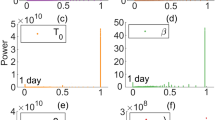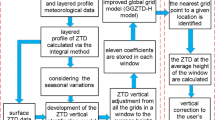Abstract
Zenith Tropospheric delay (ZTD), as one of the error sources on the Global Navigation Satellite System (GNSS) signal, plays a significant role in determining the moisture field of the earth's atmosphere. This study investigated the statistical quality of four ZTD models (HGPT2, Hopfield, Saastamoinen, and GTrop) in Iran. To do this, ZTD estimates obtained from processing GPS observations at 27 stations were considered reference values. The average Root Mean Squares Error (RMSE) values for one-year ZTD calculated using the Hopfield, HGPT2, GTrop, and Saastamoinen models were achieved at 77 mm, 39 mm, 31.4 mm, and 26 mm, respectively. The lowest mean bias values of ZTD belong to the GTrop model, which was 5.6 mm. Moreover, taking into account the temporal changes in the behavior of the ZTD parameter, the conventional Saastamoinen model was improved. The coefficients of the modified Saastamoinen model for the Iranian region were estimated with the help of GPS_ZTD values in 14 stations. Then, in 13 other stations of the GPS network that were not involved in estimating the model parameters, the modified Saastamoinen model was evaluated. On average, the modified Saastamoinen model has reduced the quantity of bias and RMSE of the calculated tropospheric delay in all the test stations about by 80% and 27%, respectively. Also, the correlation of the ZTD values obtained from the modified Saastamoinen model with GPS_ZTD has increased by 8% compared to the corresponding values obtained from the conventional Saastamoinen model.








Similar content being viewed by others
Data availability
The datasets used and/or analyzed during the current study may be made available from the corresponding author on reasonable request.
References
Bevis M, Businger S, Herring TA, Rocken C, Anthes RA, Ware RH (1992) GPS meteorology: remote sensing of atmospheric water vapor using the global positioning system. J Geophys Res-Atmos 97(D14):15787–15801. https://doi.org/10.1029/92JD01517
Bevis M, Businger S, Chiswell S, Herring TA, Anthes RA, Rocken C, Ware RH (1994) GPS meteorology: mapping zenith wet delays onto precipitable water. J Appl Meteorol 33:379–386
Black HD, Eisner A (1984) Correcting satellite Doppler data for tropospheric effects. J Geophys Res-Atmos 89:2616–2626
Bock Y, Gourevitch SA, Counselman CC III, King RW, Abbot RI (1986) Interferometric analysis of GPS phase observation. Manuscripta Geod 11:282–288
Böhm J, Heinkelmann R, Schuh H (2007) Short note: a global model of pressure and temperature for geodetic applications. J Geod 81:679–683. https://doi.org/10.1007/s00190-007-0135-3
Böhm J, Möller G, Schindelegger M, Pain G, Weber R (2015) Development of an improved empirical model for slant delays in the troposphere (GPT2w). GPS Solut 19:433–441. https://doi.org/10.1007/s10291-014-0403-7
Chen Q, Song S, Heise S, Liou YA, Zhu W, Zhao J (2011) Assessment of ZTD derived from ECMWF/NCEP data with GPS ZTD over China. GPS Solut 15:415–425. https://doi.org/10.1007/s10291-010-0200-x
Chen J, Wang J, Wang A, Ding J, Zhang Y (2020) SHAtropE—A regional gridded ZTD model for China and the surrounding areas. Remote Sens 12:165. https://doi.org/10.3390/rs12010165
Collins J, Langley R (1996) A troposphere delay model for the user of the wide area augmentation system. University of New Brunswick; Fredericton, NB, Canada. Final Contract Report, Prepared for Navigation Canada Department of Geodesy and Geomatics Engineering Technical Report No. 187
Davis JL, Herring TA, Shapiro II, Rogers AEE, Elgered G (1985) Geodesy by radio interferometry: effects of atmospheric modeling errors on estimates of baseline length. Radio Sci 20(1593):1607. https://doi.org/10.1029/RS020i006p01593\
Ding M, Hu W, Jin X, Yu L (2016) A new ZTD model based on permanent ground-based GNSS-ZTD data. Surv Rev 48:385–391. https://doi.org/10.1179/1752270615Y.0000000034
Dodson AH, Shardlow PJ, Hubbard LCM, Elgered G, Jarlemark POJ (1996) Wet tropospheric effects on precise relative GPS height determination. J Geod 70:188–202. https://doi.org/10.1007/BF00873700
Dogan AH, Erdogan B (2022) A new empirical troposphere model using ERA5’s monthly averaged hourly dataset. J Atmos Sol-Terr Phy 232:105865
Duan J, Bevis M, Fang P, Bock Y, Chiswell S, Businger S, King RW (1996) GPS meteorology: direct estimation of the absolute value of precipitable water. J Appl Meteorol Climatol 35(6):830–838
Herring T, King R, McClusky S (2020) Introduction to GAMIT/GLOBK (Release 10.7). Massachusetts Institute of Technology, Cambridge. Available online: http://geoweb.mit.edu/gg/Intro_GG.pdf. Accessed June 2020
Hopfield HS (1969) Two-quartic tropospheric refractivity profile for correcting satellite data. J Geophys Res 74:4487–4499. https://doi.org/10.1029/JC074i018p04487
Katsougiannopoulos S, Pikridas C, Rossikopoulos D, Ifadis I, Fotiou A (2006) Tropospheric refraction estimation using various models, radiosonde measurements and permanent GPS data. PS5. 4–GNSS Processing and Applications 15
Lagler K, Schindelegger M, Böhm J, Krásná H, Nilsson T (2013) GPT2: empirical slant delay model for radio space geodetic techniques. Geophys Res Lett 40(6):1069–1073
Landskron D, Böhm J (2018) VMF3/GPT3: refined discrete and empirical troposphere mapping functions. J Geod 92:349–360. https://doi.org/10.1007/s00190-017-1066-2
Leandro RF, Langley RB, Santos MC (2008) UNB3m_pack: a neutral atmosphere delay package for radiometric space techniques. GPS Solut 12:65–70. https://doi.org/10.1007/s10291-007-0077-5
Li W, Yuan Y, Ou J, Li H, Li Z (2012) A new global zenith tropospheric delay model IGGtrop for GNSS applications. Chin Sci Bull 57:2132–2139. https://doi.org/10.1007/s11434-012-5010-9
Li X, Dick G, Ge M, Heise S, Wickert J, Bender M (2014) Real-time GPS sensing of atmospheric water vapor: precise point positioning with orbit, clock, and phase delay corrections. Geophys Res Lett 41:3615–3621. https://doi.org/10.1002/2013GL058721
Li W, Yuan Y, Ou J, Chai Y, Li Z, Liou YA, Wang N (2015) New versions of the BDS/GNSS zenith tropospheric delay model IGGtrop. J Geod 89:73–80
Li W, Yuan Y, Ou J, He Y (2018) IGGtrop_SH and IGGtrop_rH: two improved empirical tropospheric delay models based on vertical reduction functions. IEEE Trans Geosci Remote 56(9):5276–5288. https://doi.org/10.1109/tgrs.2018.2812850
Liu G, Huang G, Xu Y, Ta L, Jing C, Cao Y, Wang Z (2022) Accuracy evaluation and analysis of GNSS tropospheric delay inversion from meteorological reanalysis data. Remote Sensing 14(14):3434
Mackern MV, Mateo ML, Camisay MF, Morichetti PV (2020) Tropospheric products from high-level GNSS processing in Latin America. In Beyond 100: the next century in Geodesy: Proceedings of the IAG General Assembly, Montreal, Canada, pp. 227–240
Mao J, Zhu C, Guo J (2013) A new global tropospheric zenith delay model. Geomat Inf Sci 38:684–688
Mao J, Wang Q, Liang Y, Cui T (2021) A new simplified zenith tropospheric delay model for real-time GNSS applications. GPS Solut 25:1–12. https://doi.org/10.1007/s10291-021-01092-4
Mateus P, Catalão J, Mendes VB, Nico G (2020) An ERA5-based hourly global pressure and temperature (HGPT) model. Remote Sens 12(7):1098. https://doi.org/10.3390/rs12071098
Mateus P, Mendes VB, Plecha SM (2021) HGPT2: an ERA5-based global model to estimate relative humidity. Remote Sens 13:2179. https://doi.org/10.3390/rs13112179
Mohammed J, Bingley RM, Moore T, Hill C (2020) Alternative strategy for estimating zenith tropospheric delay from precise point positioning. In 2020 IEEE/ION Position, Location and Navigation Symposium (PLANS) pp 247–258. IEEE
Myers T, Maibach E, Roser C (2013) The relationship between personal experience and belief in the reality of global warming. Nat Clim Change 3:343–347. https://doi.org/10.1038/NCLIMATE1754
Niell AE, Coster AJ, Solheim FS, Mendes VB, Toor PC, Langley RB, Upham CA (2001) Comparison of measurements of atmospheric wet delay by radiosonde, water vapor radiometer, GPS, and VLBI. J Atmos Ocean Tech 18:830–850
Penna N, Dodson A, Chen W (2001) Assessment of EGNOS tropospheric correction model. J Navig 54:37–55. https://doi.org/10.1017/S0373463300001107
Pikridas C, Katsougiannopoulos S, Zinas N (2014) A comparative study of zenith tropospheric delay and precipitable water vapor estimates using scientific GPS processing software and web based automated PPP service. Acta Geod Geophys 49:177–188. https://doi.org/10.1007/s40328-014-0047-7
Saastamoinen J (1972) Atmospheric correction for the troposphere and stratosphere in radio ranging satellites. In Geophysical Monograph Series; American Geophysical Union: Washington, DC, USA, Vol 15, pp 247–251. https://doi.org/10.1029/GM015p0247
Sáez PB, Rittmann BE (1992) Model-parameter estimation using least squares. Water Res 26(6):789–796
Sam-Khaniani A, Ghahremani M (2018) Estimation of GPS Tropospheric delays using different data processing strategies in Iran. Ann Geophys 61(6):PA663
Sguerso D, Labbouz L, Walpersdorf A (2013) 14 years of GPS tropospheric delays in the French-Italian border region: a data base for meteorological and climatological analyses. In: International workshop “the role of geomatics in hydrogeological risk”, Padua, pp 26–28
Showman AP, Dowling TE (2014) Earth as a planet: atmosphere and oceans. In Encyclopedia of the solar system. pp. 423–444. Elsevier, https://doi.org/10.1016/B978-0-12-415845-0.00020-7
Soja B, Nilsson T, Karbon M, Zus F, Dick G, Deng Z, Schuh H (2015) Tropospheric delay determination by Kalman filtering VLBI data. Earth Planets Space 67:1–16. https://doi.org/10.1186/s40623-015-0293-0
Sun L, Chen P, Wei E, Li Q (2017) Global model of zenith tropospheric delay proposed based on EOF analysis. Adv Space Res 60:187–198. https://doi.org/10.1016/j.asr.2017.03.045
Sun Z, Zhang B, Yao Y (2019) A global model for estimating tropospheric delay and weighted mean temperature developed with atmospheric reanalysis data from 1979 to 2017. Remote Sens 11:1893. https://doi.org/10.3390/rs11161893
Teke K, Nilsson T, Böhm J, Hobiger T, Steigenberger P, García-Espada S, Willis P (2013) Troposphere delays from space geodetic techniques, water vapor radiometers, and numerical weather models over a series of continuous VLBI campaigns. J Geod 87:981–1001. https://doi.org/10.1007/s00190-013-0662-z
Teten O (1930) Über einige meteorologische Begriffe. Z Geophys 6:297–309
Yang L, Hill C, Moore T (2013) Numerical weather modeling-based slant tropospheric delay estimation and its enhancement by GNSS data. Geo-Spatial Information Science 16(3):186–200
Yang F, Guo J, Meng X, Shi J, Zhang D, Zhao Y (2020a) An improved weighted mean temperature (Tm) model based on GPT2w with Tm lapse rate. GPS Solut 24:1–13. https://doi.org/10.1007/s10291-020-0953-9
Yang L, Gao J, Zhu D, Zheng N, Li Z (2020b) Improved zenith tropospheric delay modeling using the piecewise model of atmospheric refractivity. Remote Sens 12:3876. https://doi.org/10.3390/rs12233876
Yao Y, Zhu S, Yue S (2012) A globally applicable, season-specific model for estimating the weighted mean temperature of the atmosphere. J Geod 86(12):1125–1135
Yao YB, He CY, Zhang B, Xu CQ (2013) A new global zenith tropospheric delay model GZTD. Chin J Geophys 56:2218–2227
Yao Y, Hu Y, Yu C, Zhang B, Guo J (2016) An improved global zenith tropospheric delay model GZTD2 considering diurnal variations. Nonlinear Processes Geophys 23:127–136. https://doi.org/10.5194/npg-23-127-2016
Yao Y, Xu X, Xu C, Peng W, Wan Y (2019) Establishment of a real-time local tropospheric fusion model. Remote Sens 11:1321. https://doi.org/10.3390/rs11111321
Yi-Bin Y, Chang-Yong H, Zhang B, Xu CQ (2013) A new global zenith tropospheric delay model GZTD. Chin J Geophys 56:2218–22227. https://doi.org/10.6038/cjg20130709
Zhang D, Guo J, Chen M, Shi J, Zhou L (2016) Quantitative assessment of meteorological and tropospheric Zenith Hydrostatic Delay models. Adv Space Res 58(6):1033–1043
Zhang H, Yuan Y, Li W, Zhang B, Ou J (2017) A grid-based tropospheric product for China using a GNSS network. J Geod 92:765–777. https://doi.org/10.1007/s00190-017-1093-z
Zheng F, Lou Y, Gu S, Gong X, Shi C (2018) Modeling tropospheric wet delays with national GNSS reference network in China for BeiDou precise point positioning. J Geod 92:545–560. https://doi.org/10.1007/s00190-017-1080-4
Zumberge JF, Heflin MB, Jefferson DC (1997) Precise point positioning for the efficient and robust analysis of GPS data from large networks. J Geophys Res Solid Earth 102:5005–5017. https://doi.org/10.1029/96JB03860
Acknowledgements
The authors would like to thank the anonymous reviewers for taking the time and effort necessary to review the manuscript. Also, we acknowledge the funding support of Babol Noshirvani University of Technology through Grant program No. P/M/1122.
Author information
Authors and Affiliations
Contributions
The main idea of this project was proposed by Ali Sam-Khaniani. The first draft of the previous studies gathered in the introduction section was prepared by Rohollah Naeijian and finally this article was written by Ali Sam-Khaniani. Both authors contributed to the production of figures and tables. Both authors read the article and corrected the writing errors as much as possible.
Corresponding author
Ethics declarations
Competing interests
The authors declare no competing interests.
Additional information
Communicated by: H. Babaie
Publisher's note
Springer Nature remains neutral with regard to jurisdictional claims in published maps and institutional affiliations.
Rights and permissions
Springer Nature or its licensor (e.g. a society or other partner) holds exclusive rights to this article under a publishing agreement with the author(s) or other rightsholder(s); author self-archiving of the accepted manuscript version of this article is solely governed by the terms of such publishing agreement and applicable law.
About this article
Cite this article
Sam-Khaniani, A., Naeijian, R. Evaluation of modified Saastamoinen ZTD model using ground-based GPS observation over Iran. Earth Sci Inform 16, 2339–2353 (2023). https://doi.org/10.1007/s12145-023-01033-4
Received:
Accepted:
Published:
Issue Date:
DOI: https://doi.org/10.1007/s12145-023-01033-4




